An unmanned military will have no problems with firing on Americans
The U.S. Air Force is developing tiny unmanned drones that will fly in swarms, hover like bees, crawl like spiders and even sneak up on unsuspecting targets and execute them with lethal precision.
The Air Vehicles Directorate, a research arm of the Air Force, has released a computer-animated video outlining the the future capabilities of Micro Air Vehicles (MAVs). The project promises to revolutionize war by down-sizing the combatants.
‘MAVs will become a vital element in the ever-changing war-fighting environment and will help ensure success on the battlefield of the future,’ the narrator intones.
‘Unobtrusive, pervasive, lethal – Micro Air Vehicles, enhancing the capabilities of the future war fighter.’
The U.S. Air Force is developing tiny unmanned drones that will fly in swarms, hover like bees, crawl like spiders and even sneak up on unsuspecting targets and execute them with lethal precision.
The Air Vehicles Directorate, a research arm of the Air Force, has released a computer-animated video outlining the the future capabilities of Micro Air Vehicles (MAVs). The project promises to revolutionize war by down-sizing the combatants.
‘MAVs will become a vital element in the ever-changing war-fighting environment and will help ensure success on the battlefield of the future,’ the narrator intones.
‘Unobtrusive, pervasive, lethal – Micro Air Vehicles, enhancing the capabilities of the future war fighter.’ The promotional video begins with a swarm of tiny drones be dropped on a city from a passing plane.
The drones will work in concert to patch together a wide, detailed view of the battlefield – singling out individual targets without losing sight of the broader scene. ’Data will be communicated among the MAVs to enable real time, reliable decision-making and to provide an advanced overall picture for other platforms or operators,’ the Air Force says.
As the drones fall, they begin to fly – not like planes, but like insects. High frequency flapping wings allow the drones to hover and maneuver in tight spaces.
The military has already produced a drone patterned after a hawk moth that can flap its wings 30 times a second. However, the activity exhausts the drone’s tiny battery in just a few minutes, according to National Geographic.
Another drone type soars like a pigeon and perches unobtrusively on a power line to observe a surveillance target with a camera. The Air Force is working on technology that will allow the drones to steal electricity from power cables and other sources – so they can continue to operate for days or weeks on end.
Daily Mail UK
Natalee Holloway's killer Joran van der Sloot attempts to take his own life
inside maximum-security Peruvian prison
-
The 38-year-old convicted killer was found inside his cell on the brink of
death on Friday, December 12.
Πριν από 39 δευτερόλεπτα


















































Δεν υπάρχουν σχόλια:
Δημοσίευση σχολίου